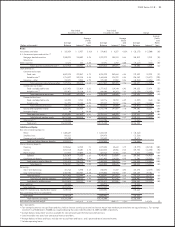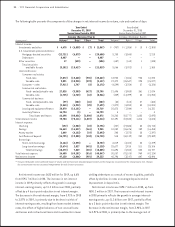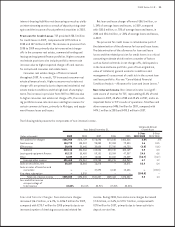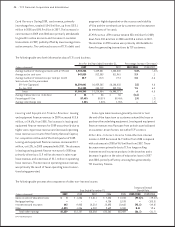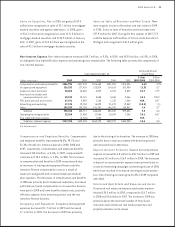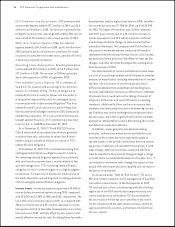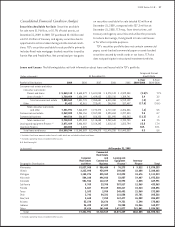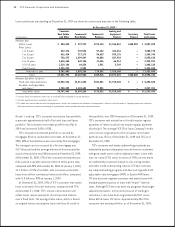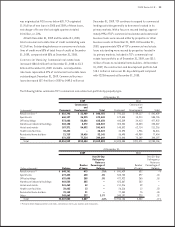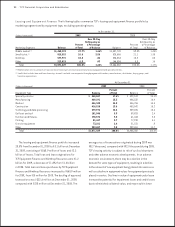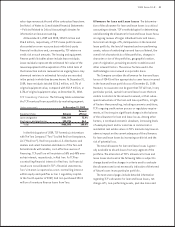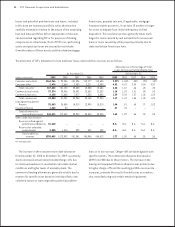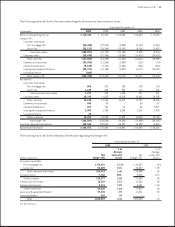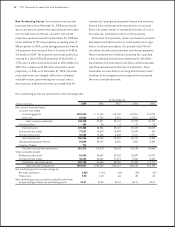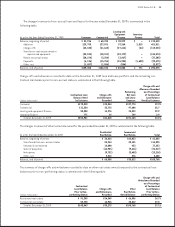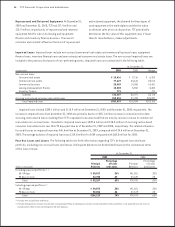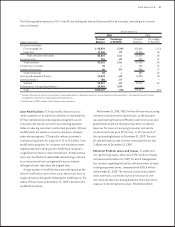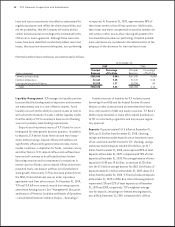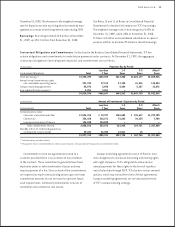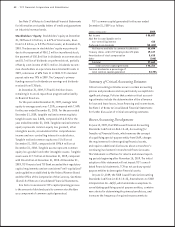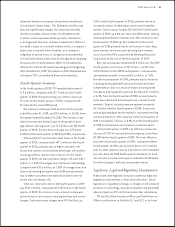TCF Bank 2009 Annual Report Download - page 47
Download and view the complete annual report
Please find page 47 of the 2009 TCF Bank annual report below. You can navigate through the pages in the report by either clicking on the pages listed below, or by using the keyword search tool below to find specific information within the annual report.
2009 Form 10-K : 31
sales-type revenue at the end of the contractual lease term.
See Note 1 of Notes to Consolidated Financial Statements
— Policies Related to Critical Accounting Estimates for
information on lease accounting.
At December 31, 2009 and 2008, $254.9 million and
$56.3 million, respectively, of TCF’s lease portfolio were
discounted on a non-recourse basis with third-party
nancial institutions and, consequently, TCF retains no
credit risk on such amounts. The leasing and equipment
nance portfolio tables above include lease residuals.
Lease residuals represent the estimated fair value of the
leased equipment at the expiration of the initial term of
the transaction and are reviewed on an ongoing basis. Any
downward revisions in estimated fair value are recorded
in the periods in which they become known. At December 31,
2009, lease residuals totaled $106.3 million, or 8.7% of
original equipment value, compared with $52.9 million, or
6.3% of original equipment value, at December 31, 2008.
TCF Inventory Finance The following table summarizes
the TCF Inventory Finance portfolio by marketing segment.
(Dollars in thousands)
Equipment Type
Lawn and garden
Electronics and appliances
Total
In the third quarter of 2009, TCF formed a joint venture
with The Toro Company (“Toro”) called Red Iron Acceptance,
LLC (“Red Iron”). Red Iron provides U.S. distributors and
dealers and select Canadian distributors of the Toro and
Exmark brands with reliable, cost-effective sources of
nancing. TCF and Toro will maintain a 55% and 45% own-
ership interest, respectively, in Red Iron. As TCF has
a controlling nancial interest in Red Iron, its nancial
results are consolidated in TCF’s nancial statements.
Toro’s interest is reported as a non-controlling interest
within equity and qualies as tier 1 regulatory capital.
In the fourth quarter of 2009, Red Iron purchased $90.8
million of inventory nance loans from Toro.
The determina-
tion of the allowance for loan and lease losses is a critical
accounting estimate. TCF’s methodologies for determining
and allocating the allowance for loan and lease losses focus
on ongoing reviews of larger individual loans and leases,
historical net charge-offs, delinquencies in the loan and
lease portfolio, the level of impaired and non-performing
assets, values of underlying loan and lease collateral, the
overall risk characteristics of the portfolios, changes in
character or size of the portfolios, geographic location,
year of origination, prevailing economic conditions and
other relevant factors. The various factors used in the
methodologies are reviewed on a periodic basis.
The Company considers the allowance for loan and lease
losses of $244.5 million appropriate to cover losses incurred
in the loan and lease portfolios as of December 31, 2009.
However, no assurance can be given that TCF will not, in any
particular period, sustain loan and lease losses that are
sizable in relation to the amount reserved, or that subse-
quent evaluations of the loan and lease portfolio, in light
of factors then prevailing, including economic conditions,
TCF’s ongoing credit review process or regulatory require-
ments, will not require signicant changes in the balance
of the allowance for loan and lease losses. Among other
factors, a continued economic slowdown, increasing levels
of unemployment and/or a decline in commercial or
residential real estate values in TCF’s markets may have an
adverse impact on the current adequacy of the allowance
for loan and lease losses by increasing credit risk and the
risk of potential loss.
The total allowance for loan and lease losses is gener-
ally available to absorb losses from any segment of the
portfolio. The allocation of TCF’s allowance for loan and
lease losses disclosed in the following table is subject to
change based on the changes in criteria used to evaluate
the allowance and is not necessarily indicative of the trend
of future losses in any particular portfolio.
The next several pages include detailed information
regarding TCF’s allowance for loan and lease losses, net
charge-offs, non-performing assets, past due loans and


